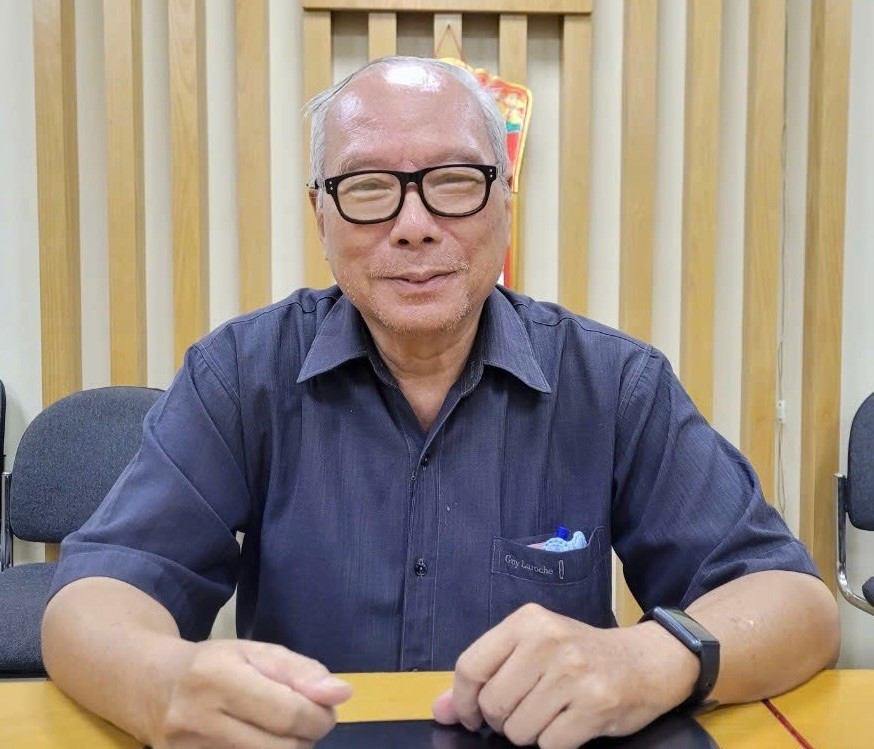In reality, universities are fragmented and small-scale.
Sir, the Ministry of Education and Training is implementing a policy to reorganize the university system, aiming for focused and targeted investment and more efficient operation. In the current context, how do you assess this policy?
For a long time, higher education has been a core part of the development strategies of most countries. Three major trends are strongly influencing the operation and reform of higher education worldwide: the trend towards multidisciplinary, multi-field, and multi-functional universities; the trend towards centralization and restructuring of the system through mergers or alliances; and the trend towards increased autonomy.
Many countries, such as France, Germany, and the Netherlands, have implemented policies of merging small or scattered universities to form multidisciplinary universities capable of competing internationally.

In Asia, South Korea, China, and Singapore have all undergone large-scale reforms. For example, Singapore, with its streamlined model of fewer but more internationally oriented schools, has formed universities like NUS and NTU, both products of restructuring and mergers.
I believe we cannot stand outside these trends. Vietnam currently has over 600 universities and colleges, most of which are small in scale, have a narrow scope of operation, and whose training and research quality does not meet the requirements of socio-economic development.
Many universities in Vietnam were established by upgrading from colleges, but they lack a modern university governance foundation. Universities in the same locality or in the same field often offer similar majors, leading to unhealthy competition and wasted resources.
Except for a few major universities such as Vietnam National University, Hanoi University of Science and Technology, Hanoi Medical University, etc., most Vietnamese universities do not have a reputation in the region, let alone internationally.
As a result, the Vietnamese university system struggles to produce truly leading institutions, while all social resources are fragmented into small, inefficient pieces.
Without groundbreaking changes, Vietnamese higher education will face serious consequences such as: declining quality, wasted public resources, loss of international competitiveness opportunities, and struggling in regional rankings.

Vietnam is facing the need to transform its growth model, moving towards a knowledge-based economy built on science, technology, and innovation. Therefore, merging smaller universities is a mandatory requirement to achieve the goal of having a strong university system by 2045, capable of training high-quality human resources.
You shouldn't try to get it right the first time.
The restructuring of universities has attracted significant public attention recently. To prevent the merger process from becoming a mechanical, bureaucratic "bureaucratization" that causes disruption, what approach do you think should be taken, sir?
To be effective, the merger needs to ensure principles of public interest, respect for university autonomy, transparency, and criteria.
The merger is not simply about reducing the number of training institutions for the sake of appearances, but aims to optimize resources, improve the quality of training and research, and better serve the needs of learners and society.
Minister of Education and Training Nguyen Kim Son affirmed that the purpose of the restructuring is to strengthen educational institutions, focusing investment on key areas and making it more effective. Small, fragmented schools that struggle with enrollment and do not meet quality standards, both public and private, will be the first to be reviewed and restructured.
The merger process must be transparent, clearly explaining the reasons, criteria, and roadmap, avoiding administrative imposition that could cause confusion among faculty and students.
Furthermore, mergers should not be carried out "once and for all," but should involve testing, evaluation, and adjustments to avoid causing shock and wasting resources.
Not all universities can merge with each other. Mergers need to be based on rigorous, scientific criteria to form sustainable, multidisciplinary universities.
For example, geographical location should be taken into account, and priority should be given to merging schools located in the same area (city, province) to utilize shared infrastructure and reduce management costs. This should avoid merging schools located far apart, which would create difficulties for students and faculty in learning and teaching.
In terms of training, universities with complementary training programs, when merged, will form a multidisciplinary university, avoiding mechanical mergers between universities with too many overlapping disciplines, which can easily lead to conflicts and a surplus of manpower.
Universities with similar missions but different strengths should be merged. For example, one university strong in engineering, another strong in economics and social sciences. This would help create universities with interdisciplinary capabilities, making it easier for them to participate in national and international research programs.
In terms of size, schools with fewer than 3,000 students should consider merging to leverage their resources.
Priority should be given to establishing world-class research universities in the country's economic, political, and social centers such as Hanoi, Ho Chi Minh City, Hue, and Da Nang. Each economic region should have at least one multidisciplinary university with an applied orientation, of sufficient scale, to both serve local workforce needs and gradually integrate internationally.
In addition, each province should have at least one multidisciplinary university of the "community university" type, of medium size, to serve the direct workforce needs of the province while also contributing to raising the general level of education in the local community.
A new governance mechanism should be implemented soon.
What impacts might this university merger have on education and training activities, and how is the sector preparing for a governance model when the University Council ceases to function?
Following the abolition of the University Council, a new governance mechanism is urgently needed for the newly formed universities after the merger. In this mechanism, the head of the institution should possess strong university governance skills and academic knowledge, not just a political position.
The merger of universities will have positive impacts such as increased efficiency in resource utilization. Universities can share common facilities such as libraries, laboratories, and dormitories. Faculty members will be allocated more rationally, especially in fields with surpluses or shortages of personnel.
This helps to create large, multidisciplinary universities capable of participating in international rankings and competing regionally. A large, prestigious multidisciplinary university will attract both domestic and international students. On the other hand, the government can more easily allocate research budgets in a focused manner, instead of fragmenting them into smaller, disjointed projects.
Foreign partners also prioritize collaborations with large-scale institutions, rather than numerous small, fragmented schools.
However, if mergers are carried out without reforming the governance mechanism, it will only lead to an bloated bureaucracy with many intermediate layers, reducing operational efficiency. This has happened before with some "national universities" and "regional universities" in Vietnam, where the management mechanism became cumbersome, overlapping, inactive, and failed to leverage the combined strengths of all institutions.
Therefore, the Ministry of Education and Training needs to design a modern governance mechanism and clearly explain the reasons, benefits, and commitments to ensuring the rights of lecturers, students, and alumni. At the same time, it needs a rational personnel policy, retaining excellent lecturers, ensuring fair placement, and avoiding feelings of "disadvantage" after the merger.
From the way countries around the world have reorganized and merged schools, Vietnam can learn a lesson: this should not be done based on administrative orders but must be linked to the national science and technology development strategy.
In my opinion, first and foremost, it is necessary to establish a basic framework of principles to regulate the entire merger process, including a legal framework and mechanisms to ensure openness and transparency; to define the governance model; to have human resource policies and incentives for development, protecting the rights of faculty and staff; and to learn from models around the world…
Universities have a responsibility to embrace change, prioritizing national and academic interests over local ones. The future of Vietnam's university system depends on which path we choose: an easy but short-term path – mergers by order to create "super universities" that exist only on paper; or a more difficult but sustainable path – mergers based on principles of transparency, autonomy, and social responsibility.
Thank you, sir!

The Minister of Education outlined the schools that will need to be restructured.

Following the major restructuring of universities: Will the gateway to university become narrower in 2026?

Higher education institutions that do not meet standards will be merged or dissolved.

140 public universities face a major restructuring and merger.
Source: https://tienphong.vn/sap-xep-cac-truong-dai-hoc-lam-the-nao-moi-hieu-qua-post1790873.tpo


![[Photo] Prime Minister Pham Minh Chinh receives Lao Minister of Education and Sports Thongsalith Mangnormek](/_next/image?url=https%3A%2F%2Fvphoto.vietnam.vn%2Fthumb%2F1200x675%2Fvietnam%2Fresource%2FIMAGE%2F2025%2F12%2F16%2F1765876834721_dsc-7519-jpg.webp&w=3840&q=75)


![[Image] Leaked images ahead of the 2025 Community Action Awards gala.](/_next/image?url=https%3A%2F%2Fvphoto.vietnam.vn%2Fthumb%2F1200x675%2Fvietnam%2Fresource%2FIMAGE%2F2025%2F12%2F16%2F1765882828720_ndo_br_thiet-ke-chua-co-ten-45-png.webp&w=3840&q=75)
![[Live] 2025 Community Action Awards Gala](/_next/image?url=https%3A%2F%2Fvphoto.vietnam.vn%2Fthumb%2F1200x675%2Fvietnam%2Fresource%2FIMAGE%2F2025%2F12%2F16%2F1765899631650_ndo_tr_z7334013144784-9f9fe10a6d63584c85aff40f2957c250-jpg.webp&w=3840&q=75)
![[Photo] Prime Minister Pham Minh Chinh receives the Governor of Tochigi Province (Japan)](/_next/image?url=https%3A%2F%2Fvphoto.vietnam.vn%2Fthumb%2F1200x675%2Fvietnam%2Fresource%2FIMAGE%2F2025%2F12%2F16%2F1765892133176_dsc-8082-6425-jpg.webp&w=3840&q=75)



























































![[Photo] Prime Minister Pham Minh Chinh attends the Vietnam Economic Forum 2025](https://vphoto.vietnam.vn/thumb/402x226/vietnam/resource/IMAGE/2025/12/16/1765893035503_ndo_br_dsc-8043-jpg.webp)





































Comment (0)